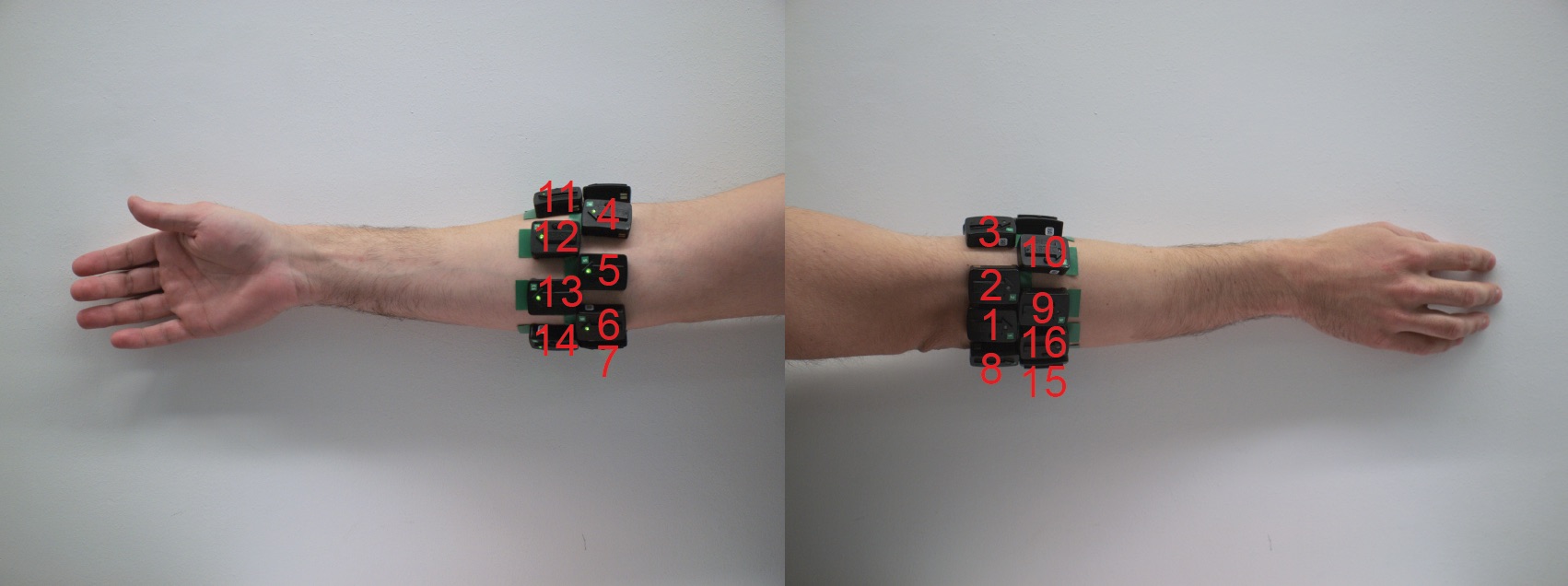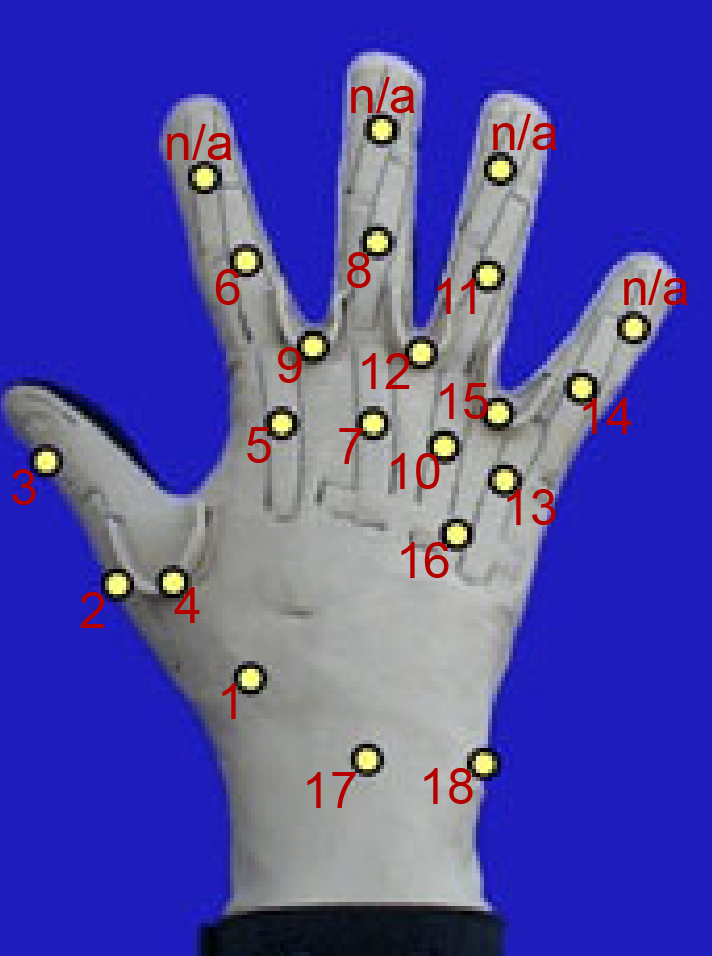DB8 Guidelines
Overview
This Ninapro dataset is intended to be used for estimation/reconstruction
of finger movement rather than motion/grip classification.
In other words, the purpose of this database is to provide a benchmark for
decoding finger position from (contralateral) EMG measurements using
regression algorithms as opposed to classification.
Publications
The dataset is described in detail in the following scientific paper.
Please, refer to it for detailed guidelines and cite it in case you use
this dataset.
Instructions
Subjects
Ten able-bodied (Subjects 1-10) and two right-hand transradial amputee
participants (Subjects 11-12) are included in the dataset. During the
acquisition, the subjects were asked to repeat 9 movements using both
hands (bilateral mirrored movements).
Acquisition Setup
-
EMG & IMU: The muscular activity was recorded using 16 active
double-differential wireless sensors from a Delsys Trigno IM Wireless
EMG system. The sensors comprise EMG electrodes and 9-axis inertial
measurement units (IMUs). The sensors were positioned in two rows of
eight units around the participants right forearm in correspondence
to the radiohumeral joint (see pictures below). No specific muscles
were targeted. The sensors were fixed on the forearm using the
standard manufacturer-provided adhesive bands. Moreover, a
hypoallergenic elastic latex-free band was placed around the sensors
to keep them fixed during the acquisition. The sEMG signals were
sampled at a rate of 1111 Hz, accelerometer and gyroscope data were
sampled at 148 Hz, and magnetometer data were sampled at 74 Hz. All
signals were upsampled to 2 kHz and post-synchronized.
-
Kinematics: Hand kinematic data were recorded with a dataglove
(Cyberglove 2, 18-DOF model). For all participants (i.e. both
able-bodied and amputee), the data glove was worn on the left hand
(i.e. contralateral to the arm where the EMG sensors were located).
The Cyberglove signals correspond to data from the associated
Cyberglove sensors located as shown in the picture below ("n/a"
corresponds to sensors that were not available, since an 18-DOF model
was used). Prior to each experimental session, the data glove was
calibrated for the specific participant using the "quick calibration"
procedure provided by the manufacturer. The Cyberglove signals were
sampled at 100 Hz and subsequently upsampled to 2 kHz and synchronized
to EMG and IMU data.
Acquisition Protocol
The experiment comprised nine movements including single-finger as well as
functional movements. The subjects had to repeat the instructed movements
following visual cues (i.e. movies) shown on the screen of a computer
monitor. The duration of each of the nine movements varied between 6 and 9
seconds and consecutive trials were interleaved with 3 seconds of rest.
Each repetition started with the participant holding their fingers at the
rest state and involved slowly reaching the target posture as shown on the
screen and returning to the rest state before the end of the trial. The
following movements were included:
- 0. rest
- 1. thumb flexion/extension
- 2. thumb abduction/adduction
- 3. index finger flexion/extension
- 4. middle finger flexion/extension
- 5. combined ring and little fingers flexion/extension
- 6. index pointer
- 7. cylindrical grip
- 8. lateral grip
- 9. tripod grip
During the acquisition, the subjects were asked to repeat the movements
with the right hand (phantom limb in the case of amputees). Each movement
repetition lasted 5 seconds and was followed by 3 seconds of rest. The
protocol includes 6 repetitions of 40 different movements (plus rest). One
of the amputee subjects (Subject 21) did not perform the final two
(functional) movements of Exercise 2; therefore, the number of classes
associated with this subject is 38.
Dataset variables
For each participant, three datasets were collected: the first two
datasets (acquisitions 1 & 2) comprised 10 repetitions of each movement
and the third dataset (acquisition 3) comprised only two repetitions.
For each subject, the associated .zip file contains three MATLAB files in
.mat format, that is, one for each dataset, with synchronized variables.
The variables included in the .mat files are the following:
- Subject: subject number.
- Exercise: exercise number (value set to 1 in all data files).
- emg (16 columns): sEMG signal.
- acc (48 columns): three-axes accelerometers of the 16 sensors.
- gyro (48 columns): three-axes gyroscopes of the 16 sensors.
- mag (48 columns): three-axes magnetometers of the 16 sensors
-
Glove (18 columns): calibrated signal from the sensors of the
cyberglove.
The cyberglove signal corresponds to data from the cyberglove
sensors located as shown in the following picture; "n/a" corresponds
to not available sensors, since an 18-DOF model was used. Prior to
each experiment, the data glove was calibrated to the specific
subject using the "quick calibration" procedure provided by the
manufacturer.
-
Stimulus (1 column): the movement repeated by the subject, according
to the displayed movie.
-
Restimulus (1 column): the movement repeated by the subject, but with
the duration of the movement label refined a-posteriori in order to
better correspond to the real movement.
- Repetition (1 column): repetition of the stimulus.
- Rerepetition (1 column): repetition of restimulus.
Important notes
Given the nature of the data collection procedure (slow finger movement
and lack of extended hold period), this database is intended to be used
for estimation/reconstruction of finger movement rather than motion/grip
classification. In other words, the purpose of this database is to provide
a benchmark for decoding finger position from (contralateral) EMG
measurements using regression algorithms as opposed to classification.
Therefore, the use of stimulus/restimulus vectors as target variables
should be avoided; these are only provided for the user to have access to
the exact timings of each movement repetition.
Three datasets/acquisitions are provided for each subject. It is
recommended that dataset 3, which comprises only two repetitions for each
movement, is only used to report performance results and no training or
hyper-parameter tuning is performed using this data (i.e. test dataset).
The three datasets, which were recorded sequentially, can offer an
out-of-the-box three-way split for model training (dataset 1),
hyper-parameter tuning/validation (dataset 2), and performance testing
(dataset 3). Another possibility is to merge datasets 1 & 2 and perform
training and validation/hyper-parameter tuning using K-fold
cross-validation, then report performance results on dataset 3.

Acquisition procedure.

EMG sensors location.

Cyberglove sensors location.


